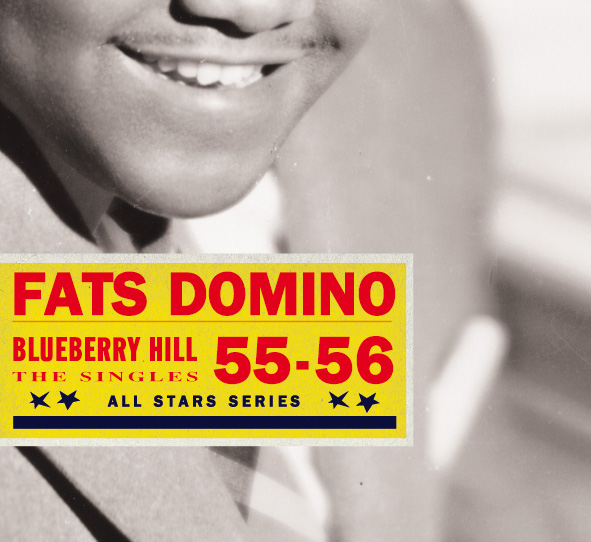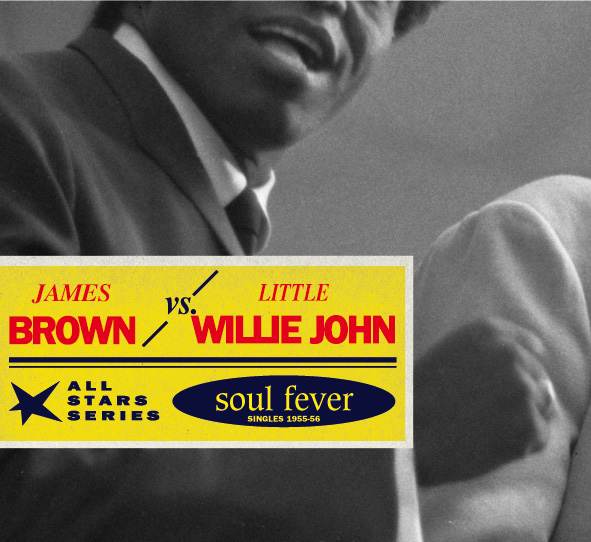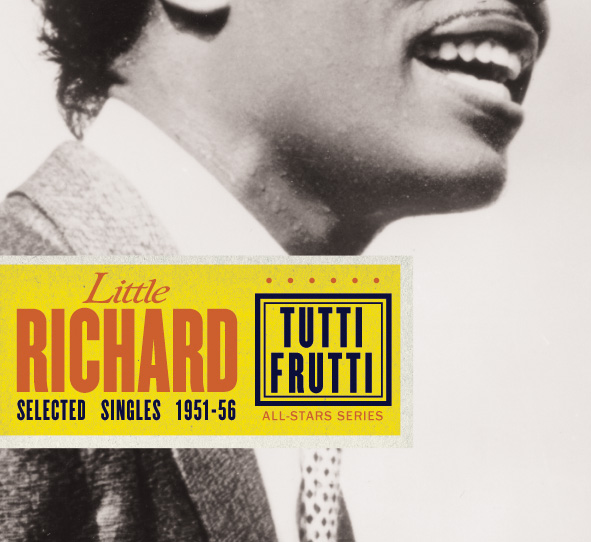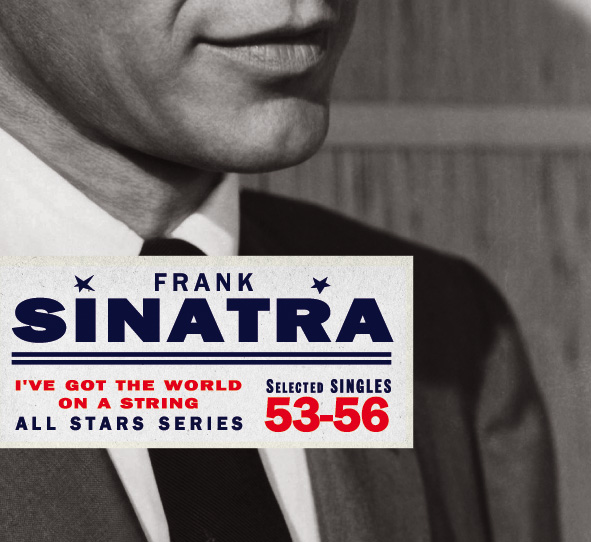★

01 FATS DOMINO Blueberry Hill / Selected Singles 1955-1956
Le pianiste et chanteur Antoine ‘Fats’ Domino est sans conteste le plus célèbre représentant du rhythm and blues façon Nouvelle-Orléans. Au milieu des années 1950, Fats est au sommet de sa carrière, son timbre de voix chaleureux et son style de piano chaloupé parfaitement maîtrisés lui assurent les premières places des charts R&B. Ain’t That a Shame, All by Myself, Poor Me, Blueberry Hill tous no. 1 sont présents dans notre sélection.
Pianist and singer Antoine ‘Fats’ Domino is arguably the most famous exponent of New Orleans-style rhythm and blues. In the mid-1950s, Fats was at the peak of his career, his warm vocal timbre and perfectly mastered swaying piano style ensuring him top spot in the R&B charts. Ain’t That a Shame, All by Myself, Poor Me, Blueberry Hill all No. 1 are present in our selection.

02 RAY CHARLES I Got a Woman / Selected Singles 1952-1955
L’année 1952 marque un tournant important dans la carrière de Ray Charles. À partir de cette date, son style se démarquant nettement de celui de ses idoles Nat King Cole et Charles Brown, celui qu’on nomme ‘The Genius’ enregistre à New York une série de titres qui feront date dans l’histoire de la soul music. De The Midnigh Hour à I Got a Woman, déchirant sa voix jusqu’à l’orgasme, Ray résout l’équation “blues + gospel = soul” de la plus belle manière qui soit.
The year 1952 marked an important turning point in Ray Charles’ career. From that date onwards, his style clearly distinguishing itself from that of his idols Nat King Cole and Charles Brown, the man known as ‘The Genius’ recorded a series of tracks in New York that would go down in the history of soul music. From The Midnigh Hour to I Got a Woman, ripping his voice to orgasm, Ray solves the “blues + gospel = soul” equation in the most beautiful way possible.

03 JAMES BROWN vs. LITTLE WILLIE JOHN Soul Fever / Selected Singles 1955-1956
Ou les débuts de deux jeunes chanteurs qui vont dynamiter la scène R&B. Le premier qui cartonne en 1956 avec Please, Please, Please, connaîtra la carrière que l’on sait et sera proclamé Parrain de la Soul. Le second, créateur du titre Fever, repris par Peggy Lee et Elvis Presley entre autres, est un pilier incontestable de la soul music et une influence majeure pour des chanteurs tels que Sam Cooke, B. B. King ou Al Green.
Or the beginnings of two young singers who were to rock the R&B scene. The first, who hit it big in 1956 with Please, Please, Please, had the career we know and was proclaimed the “Godfather of Soul.” The second, creator of the song Fever, covered by Peggy Lee and Elvis Presley among others, was an indisputable pillar of soul music and a major influence on singers such as Sam Cooke, B. B. King and Al Green.

04 LITTLE RICHARD Tutti Frutti / Selected Singles 1951-1956
Nourri au gospel dès sa plus tendre enfance passée en Georgie, Little Richard est au début des années 1950 un formidable chanteur et pianiste de rhythm and blues. L’enregistrement en 1955 du célébrissime Tutti Frutti dévoilera au monde la folie exubérante de cet artiste original et originel, pur concentré de rock’n’roll.
Nurtured on gospel music since his early childhood in Georgia, Little Richard was a formidable rhythm and blues singer and pianist by the early 1950s. The 1955 recording of the celebrated Tutti Frutti revealed to the world the exuberant madness of this original artist, a pure concentrate of rock’n’roll.

05 BILL HALEY R-O-C-K / Selected Singles 1954-1955
Souvent oublié dans l’histoire du rock‘n’roll, Bill Haley en fut néanmoins l’un des pionniers. Bien avant l’invention du terme, Bill Haley et ses comètes posaient les premiers jalons d’un genre en plein devenir. La consécration arrivera au printemps 1955 avec le tube planétaire Rock Around the Clock, qui restera au sommet des charts durant 8 semaines consécutives aux États-Unis.
Often forgotten in the history of rock’n’roll, Bill Haley was nevertheless one of its pioneers. Long before the term was invented, Bill Haley and his comets were laying the foundations for a genre in full development. His breakthrough came in the spring of 1955 with the worldwide hit Rock Around the Clock, which stayed at the top of the charts for 8 consecutive weeks in the USA.

06 CHUCK BERRY Roll Over Bethoven / The Singles 1955-56
Fils d’un pasteur de Saint Louis, Charles Edward Anderson Berry aura vite déserté les bancs de l’église pour la moiteur des clubs de l’East Saint Louis. C’est grâce au soutien de son idole Muddy Waters qu’il grave à Chicago ses premiers singles : Maybellene, Wee Wee Hours, Thirty Days… Le monde ne s’en remettra pas. Adulé par les Beatles et les Rolling Stones (Keith Richards en tête), le Beach Boy Brian Wilson avoue son admiration : “Il a écrit les meilleures chansons et inventé tous les rythmes du rock’n’roll”. CQFD
The son of a Saint Louis pastor, Charles Edward Anderson Berry soon deserted the church pews for the muggy clubs of East Saint Louis. Thanks to the support of his idol Muddy Waters, he recorded his first singles in Chicago: Maybellene, Wee Wee Hours, Thirty Days… The world would never recover. Adored by the Beatles and the Rolling Stones (led by Keith Richards), Beach Boy Brian Wilson confesses his admiration: “He wrote the best songs and invented all the rhythms of rock’n’roll.”

07 ELVIS PRESLEY The Birth of the King / Selected Singles 1954-56
Au commencement était le blues. Le jeune Elvis l’a bien compris, il raffole des chansons d’Arthur ‘Big Boy’ Crudup et de Kokomo Arnold – That’s All Right Mama, My Baby Left Me, Milkcow Blues… – qui composent à ses débuts une bonne partie de son répertoire. Ce sont les versions du jeune homme de Memphis qui resteront dans toutes les mémoires, sa popularité exponentielle l’élèvera au rang de Roi et le phénomène Elvis changera à tout jamais l’histoire de la musique populaire.
In the beginning was the blues. The young Elvis understood this, and loved the songs of Arthur ‘Big Boy’ Crudup and Kokomo Arnold—That’s All Right Mama, My Baby Left Me, Milkcow Blues…—which made up a large part of his early repertoire. It’s the versions by the young man from Memphis that will live long in the memory, his exponential popularity elevating him to the rank of King, and the Elvis phenomenon changing the history of popular music forever.

08 GENE VINCENT Be Bop a Lula / 1956
Enregistrées en l’espace de quelques jours, les premières faces de Gene Vincent ici reproduites font partie des joyaux du rock’n’roll. Dans une parfaite osmose Gene Vincent et ses Blue Caps – dont l’excellent guitariste Cliff Gallup – alternent rocks endiablés et ballades envoûtantes avec un même talent. Cinquante années plus tard, Be Bop a Lula, Race with the Devil et Bluejean Bop n’ont rien perdu de leur fraîcheur ni de leur modernité.
Recorded in the space of a few days, the first Gene Vincent sides reproduced here are among the gems of rock’n’roll. In perfect osmosis, Gene Vincent and his Blue Caps—including the excellent guitarist Cliff Gallup—alternate frenzied rocks and spellbinding ballads with equal talent. Fifty years on, Be Bop a Lula, Race with the Devil and Bluejean Bop have lost none of their freshness or modernity.

09 FRED ASTAIRE I Won’t Dance! / 1952
Sa vocation première n’était peut-être pas le chant mais force est d’avouer qu’il eût été dommage que Fred Astaire se contentât uniquement de danser ! Avec la même grâce et cette douce élégance qui font de lui un des plus grands artistes américains du XXe siècle, Fred Astaire se livre ici à une interprétation des standards immortels de Cole Porter, Irving Berlin, George et Ira Gershwin.
His first vocation may not have been singing, but it would have been a shame if Fred Astaire had only danced! With the same grace and gentle elegance that made him one of the greatest American artists of the 20th century, Fred Astaire performs immortal standards by Cole Porter, Irving Berlin and George and Ira Gershwin.

10 FRANK SINATRA I’ve Got the World on a String / Selected Singles 1953-56
À quelque extra-terrestre débarquant de sa lointaine planète, il ne faudrait pas plus que ces 16 précieux gemmes pour lui expliquer en quoi Frank Sinatra est probablement LE chanteur. Timing irréprochable, densité extraordinaire du flux vocal, complémentarité exemplaire avec la luxuriance des orchestrations de Nelson Riddle : n’en jetez plus, le swing c’est ici !
Any alien from a distant planet would need no more than these 16 precious gems to explain why Frank Sinatra is probably THE singer. Irreproachable timing, extraordinary density of vocal flow, exemplary complementarity with Nelson Riddle’s lush orchestrations: don’t waste any more time, swing is here!
